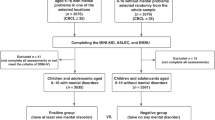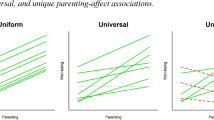Abstract
Background
Positive parental interactions may buffer maltreated children from poor psychosocial outcomes. The study aims to evaluate the associations between various types of maltreatment and psychosocial outcomes in early childhood, and examine the moderating effect of positive parent–child interactions on them.
Methods
Data were from a representative Chinese 6-year-old children sample (n = 17,088). Caregivers reported the history of child maltreatment perpetrated by any individuals, completed the Strengths and Difficulties Questionnaire as a proxy for psychosocial well-being, and reported the frequency of their interactions with children by the Chinese Parent–Child Interaction Scale.
Results
Physical abuse, emotional abuse, neglect, and sexual abuse were all associated with higher odds of psychosocial problems (aOR = 1.90 [95% CI: 1.57–2.29], aOR = 1.92 [95% CI: 1.75–2.10], aOR = 1.64 [95% CI: 1.17–2.30], aOR = 2.03 [95% CI: 1.30–3.17]). Positive parent–child interactions were associated with lower odds of psychosocial problems after accounting for different types of maltreatment. The moderating effect of frequent parent–child interactions was found only in the association between occasional only physical abuse and psychosocial outcomes (interaction term: aOR = 0.34, 95% CI: 0.15–0.77).
Conclusions
Maltreatment and positive parent–child interactions have impacts on psychosocial well-being in early childhood. Positive parent–child interactions could only buffer the adverse effect of occasional physical abuse on psychosocial outcomes. More frequent parent–child interactions may be an important intervention opportunity among some children.
Impact
-
It provides the first data on the prevalence of different single types and combinations of maltreatment in early childhood in Shanghai, China by drawing on a city-level population-representative sample.
-
It adds to evidence that different forms and degrees of maltreatment were all associated with a higher risk of psychosocial problems in early childhood. Among them, sexual abuse posed the highest risk, followed by emotional abuse.
-
It innovatively found that higher frequencies of parent–child interactions may provide buffering effects only to children who are exposed to occasional physical abuse.
-
It provides a potential intervention opportunity, especially for physically abused children.
This is a preview of subscription content, access via your institution
Access options
Subscribe to this journal
Receive 14 print issues and online access
$259.00 per year
only $18.50 per issue
Buy this article
- Purchase on Springer Link
- Instant access to full article PDF
Prices may be subject to local taxes which are calculated during checkout

Similar content being viewed by others
Data availability
The datasets generated during and/or analyzed during the current study are not publicly available due to shared ownership of Shanghai Municipal Education Commission but are available from the corresponding author on reasonable request.
References
Stoltenborgh, M., Bakermans-Kranenburg, M. J., Alink, L. R. A. & van Ijzendoorn, M. H. The prevalence of child maltreatment across the globe: review of a series of meta-analyses. Child Abus. Rev. 24, 37–50 (2015).
Ratanatharathorn, A. et al. Polygenic risk for autism, attention-deficit hyperactivity disorder, schizophrenia, major depressive disorder, and neuroticism is associated with the experience of childhood abuse. Mol. Psychiatry 26, 1696–1705 (2021).
Polanco-Roman, L. et al. Association of childhood adversities with suicide ideation and attempts in Puerto Rican young adults. JAMA Psychiatry 78, 896–902 (2021).
Hailes, H. P., Yu, R., Danese, A. & Fazel, S. Long-term outcomes of childhood sexual abuse: an umbrella review. Lancet Psychiatry 6, 830–839 (2019).
U.S. Department of Health & Human Services, Administration for Children and Families, Administration on Children, Youth and Families, Children’s Bureau. Chilld maltreatment 2020. https://www.acf.hhs.gov/cb/data-research/child-maltreatment (2020).
Grantham-McGregor, S. et al. Developmental potential in the first 5 years for children in developing countries. Lancet 369, 60–70 (2007).
Holz, N. E., Tost, H. & Meyer-Lindenberg, A. Resilience and the brain: a key role for regulatory circuits linked to social stress and support. Mol. Psychiatry 25, 379–396 (2020).
Yule, K., Houston, J. & Grych, J. Resilience in children exposed to violence: a meta-analysis of protective factors across ecological contexts. Clin. Child Fam. Psychol. Rev. 22, 406–431 (2019).
Ginsburg, K. R., American Academy of Pediatrics Committee on Communications & American Academy of Pediatrics Committee on Psychosocial Aspects of Child & Family Health. The importance of play in promoting healthy child development and maintaining strong parent-child bonds. Pediatrics 119, 182–191 (2007).
Boeldt, D. L. et al. The association between positive parenting and externalizing behavior. Infant Child Dev. 21, 85–106 (2012).
Engle, P. L. et al. Strategies for reducing inequalities and improving developmental outcomes for young children in low-income and middle-income countries. Lancet 378, 1339–1353 (2011).
Jiang, Z. et al. Parent-child relationship quality, childhood maltreatment, and psychological symptoms in Chinese adolescent. J. Interpers. Violence 37, NP18130-NP18151 (2022).
Fagan, A. A. Child maltreatment and aggressive behaviors in early adolescence: evidence of moderation by parent/child relationship quality. Child Maltreat. 25, 182–191 (2020).
Corlis, M. & Damashek, A. Examining parental factors as moderators between maltreatment and adolescent delinquency. J. Interpers. Violence 36, NP9391–NP9415 (2021).
Wilkinson, A., Lantos, H., McDaniel, T. & Winslow, H. Disrupting the link between maltreatment and delinquency: how school, family, and community factors can be protective. BMC Public Health 19, 588 (2019).
Yoon, S., Yoon, D., Latelle, A. & Kobulsky, J. M. The interaction effects between father-child relationship quality and parent-perpetrated maltreatment on adolescent behavior problems. J. Interpers. Violence 37, NP15944–NP15969 (2022).
Lind, M. J. et al. Does parenting influence the enduring impact of severe childhood sexual abuse on psychiatric resilience in adulthood? Child Psychiatry Hum. Dev. 49, 33–41 (2018).
Shin, S. H. et al. Childhood maltreatment and alcohol-related problems in young adulthood: the protective role of parental warmth. Child Abus. Negl. 98, 104238 (2019).
Teicher, M. H., Samson, J. A., Polcari, A. & McGreenery, C. E. Sticks, stones, and hurtful words: relative effects of various forms of childhood maltreatment. Am. J. Psychiatry 163, 993–1000 (2006).
Wang, X. et al. Cohort profile: the Shanghai Children’s Health, Education and Lifestyle Evaluation, Preschool (SCHEDULE-P) study. Int. J. Epidemiol. 50, 391–399 (2021).
Shan, W. et al. Association between maltreatment, positive parent-child interaction, and psychosocial well-being in young children. J. Pediatr. 213, 180.e1–186.e1 (2019).
Wang, Z. et al. The association between child maltreatment and sleep disturbances among preschoolers. Child Abus. Negl. 127, 105525 (2022).
Salum, G. A. et al. Measuring child maltreatment using multi-informant survey data: a higher-order confirmatory factor analysis. Trends Psychiatry Psychother. 38, 23–32 (2016).
Zhao, J. et al. Excessive screen time and psychosocial well-being: the mediating role of body mass index, sleep duration, and parent-child interaction. J. Pediatr. 202, 157.e1–162.e1 (2018).
Ip, P. et al. Rasch validation of the Chinese parent-child interaction scale (CPCIS). World J. Pediatr. 14, 238–246 (2018).
Goodman, R. The Strengths and Difficulties Questionnaire: a research note. J. Child Psychol. Psychiatry 38, 581–586 (1997).
Du, Y., Kou, J. & Coghill, D. The validity, reliability and normative scores of the parent, teacher and self report versions of the Strengths and Difficulties Questionnaire in China. Child Adolesc. Psychiatry Ment. Health 2, 8 (2008).
Jianhua, K., Yasong, D. & Liming, X. Reliability and validity of “children strengths and difficulties questionnaire” in Shanghai norm. Shanghai Arch. Psychiatry 17, 25–28 (2005).
MacMillan, H. L. et al. Childhood abuse and lifetime psychopathology in a community sample. Am. J. Psychiatry 158, 1878–1883 (2001).
Meinck, F. et al. Factor structure and internal consistency of the ISPCAN Child Abuse Screening Tool Parent Version (ICAST-P) in a cross-country pooled data set in nine Balkan countries. Child Abus. Negl. 115, 105007 (2021).
Chan, K., Fong, D. Y., Yan, E., Chow, C. & Ip, P. Validation of the Chinese juvenile victimisation questionnaire. Hong Kong J. Paediatr. 16, 17–24 (2011).
Smith, C. A., Ireland, T. O., Thornberry, T. P. & Elwyn, L. Childhood maltreatment and antisocial behavior: comparison of self-reported and substantiated maltreatment. Am. J. Orthopsychiatry 78, 173–186 (2008).
Shonkoff, J. P. et al. The lifelong effects of early childhood adversity and toxic stress. Pediatrics 129, e232–e246 (2012).
Chiocca, E. M. American parents’ attitudes and beliefs about corporal punishment: an integrative literature review. J. Pediatr. Health Care 31, 372–383 (2017).
Ni, Y. & Hesketh, T. Child maltreatment in China: a cross-sectional study of prevalence and attitudes among young adults. Lancet 386, S52 (2015).
Heim, C. M., Mayberg, H. S., Mletzko, T., Nemeroff, C. B. & Pruessner, J. C. Decreased cortical representation of genital somatosensory field after childhood sexual abuse. Am. J. Psychiatry 170, 616–623 (2013).
Mokma, T. R., Eshelman, L. R. & Messman-Moore, T. L. Contributions of child sexual abuse, self-blame, posttraumatic stress symptoms, and alcohol use to women’s risk for forcible and substance-facilitated sexual assault. J. Child Sex. Abus. 25, 428–448 (2016).
Purcell, J. B. et al. Stress-elicited neural activity in young adults varies with childhood sexual abuse. Cortex 137, 108–123 (2021).
Schalinski, I., Teicher, M. H. & Rockstroh, B. Early neglect is a key determinant of adult hair cortisol concentration and is associated with increased vulnerability to trauma in a transdiagnostic sample. Psychoneuroendocrinology 108, 35–42 (2019).
Dickerson, K. L., Lavoie, J. & Quas, J. A. Do laypersons conflate poverty and neglect? Law Hum. Behav. 44, 311–326 (2020).
Goodman, R., Ford, T., Simmons, H., Gatward, R. & Meltzer, H. Using the Strengths and Difficulties Questionnaire (SDQ) to screen for child psychiatric disorders in a community sample. Br. J. Psychiatry 177, 534–539 (2000).
Milner, J. S. & Crouch, J. L. Impact and detection of response distortions on parenting measures used to assess risk for child physical abuse. J. Pers. Assess. 69, 633–650 (1997).
Acknowledgements
We thank the study statistical expert Dr. Hao Pan.
Funding
This study was supported by the National Natural Science Foundation of China (82103866), Shanghai Municipal Health Commission (20214Y0112), Shanghai Municipal Education Commission (2022you1-2, D1502), and The Innovative Research Team of High-level Local Universities in Shanghai (SHSMU-ZDCX20211900).
Author information
Authors and Affiliations
Contributions
W.S., Y.Z., and F.J. took the initiative in conception and design, and W.S. analyzed the data and completed the draft. W.S., Y.Z., J.Z., and S.W. collected the data and provided critical suggestions on data analysis. F.J., L.Z., P.I., and J.D.T. made substantial contributions to the interpretation of data and manuscript revision.
Corresponding authors
Ethics declarations
Competing interests
The authors declare no competing interests.
Ethics approval and consent to participate
The study received approval from the institutional review board of the Shanghai Children’s Medical Center, Shanghai Jiao Tong University (SCMCIRB-K2016022-01). Parents of the involved children signed the informed consent before participating in the study.
Additional information
Publisher’s note Springer Nature remains neutral with regard to jurisdictional claims in published maps and institutional affiliations.
Supplementary information
Rights and permissions
Springer Nature or its licensor (e.g. a society or other partner) holds exclusive rights to this article under a publishing agreement with the author(s) or other rightsholder(s); author self-archiving of the accepted manuscript version of this article is solely governed by the terms of such publishing agreement and applicable law.
About this article
Cite this article
Shan, W., Zhang, Y., Zhao, J. et al. Positive parent–child interactions moderate certain maltreatment effects on psychosocial well-being in 6-year-old children. Pediatr Res 95, 802–808 (2024). https://doi.org/10.1038/s41390-023-02842-5
Received:
Revised:
Accepted:
Published:
Issue Date:
DOI: https://doi.org/10.1038/s41390-023-02842-5



